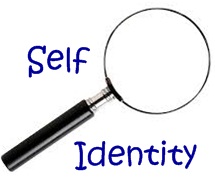Self-Identity
Self-identity is how you identify and define yourself. It is your perception of specific and selective traits, qualities, abilities, and characteristics that represent you. As an individual, you have numerous physical attributes, internal characteristics, social roles, and external connections which make up your personal identity.
Your self-identity is a combination of personality traits, abilities, physical attributes, interests, hobbies, and/or social roles from your personal identity that you specifically selected to identify yourself.
Your personal identity is a composite of all your personality traits, beliefs, values, physical attributes, abilities, aspirations, and other identifiers that make you who you are. It is larger and more encompassing than your self-identity. Your self-identity is just your perspective of your personal identity. You may not perceive or value some of the traits that make up your personal identity, so you do not incorporate them as part of your self-identity. Simply put, personal identity is who you are, while self-identity is who you see or define yourself to be.
Based on Self-Concept
As individuals, we identify ourselves based on our self-concept. Self-concept is how we perceive ourselves. It is this perception of ourselves that leads to the way we define or identify ourselves. Basically, we take our perceptions of ourselves and create our self identity.
Since self identity is based on self-concepts, you will distort your self-identity due to self-image or self-esteem. If you have a low self-image or low self-esteem, you may not perceive yourself as valuable, in turn you will not define yourself as valuable. Therefore, it is important to have a positive self-image and high self-esteem when creating your self-identity. If you have low self-esteem, you should work on increasing that before you focus on creating your self-identity.
Focus of Self-Identity
As earlier indicated, your self-identity is created by combining selective attributes, traits, or social roles from your personal identity. What aspects you chose, how many you chose, and the weight you give those individual aspects is up to you. You may chose to focus your identity on your occupation, or you may choose to keep a broad perspective of your characteristics and attributes. It is up to you.
Many people base their self identity in relation to social context or social roles (e.g. occupation, coach, leader, basketball player, father, mother, etc.). While it is easier for the mind to identify or picture a social role such as a doctor than a personal characteristic like empathic, you want to try to include as many aspects as you can when forming you identity.
Unfortunately, some people create their self-identity in a narrow view. They strongly tie it to just a single or a few parts of your personal identity. However, self identity should encompass much more. Some people firmly tie their self identity to their occupation, and if they lose their job, they often will struggle with finding their self-identity.
It doesn’t interest me what you do for a living. I want to know what you ache for and if you dare to dream of meeting your heart’s longing. – Oriah Mountain Dreamer
Creating your self-identity
- Do you typically identify yourself by what you do (e.g. architect, software technician, doctor, teacher, interior designer, engineer, etc…)?
- Do you identify yourself with your societal position (e.g. father, sister, friend, leader, etc…)?
- Do you use physical characteristics (e.g. short, tall, balding, blue eyes, curly hair, etc…)?
- Do you tend to identify yourself with your characteristics (e.g. I am a confident, I am smart, I am optimist, I have a positive attitude, etc…)?





